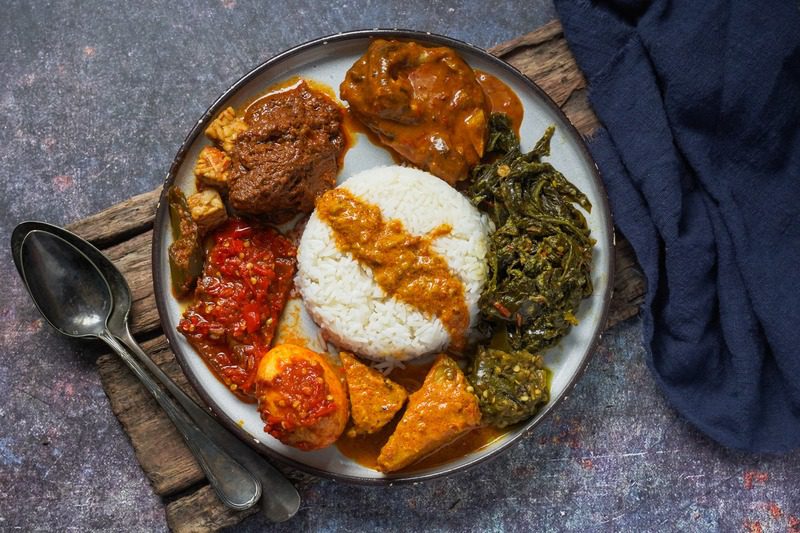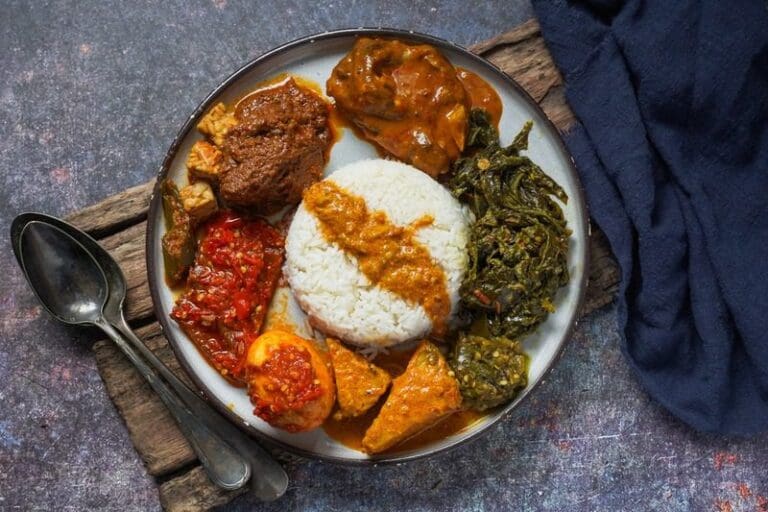Nasi Padang hails from Padang in Indonesia. Traditionally, the meal consists of steamed rice served with an array of complementary items, which could include meat, fish, vegetables, and spicy sambals.
I love dishes like this because they fill you up and are packed with a wide variety of flavors. The different plate components make it feel like a luxurious meal, even though the individual components themselves are quite humble.

Indonesian-Inspired Nasi Padang
Nasi Padang hails from Padang in Indonesia. Traditionally, the meal consists of steamed rice served with an array of complementary items, which could include meat, fish, vegetables, and spicy sambals.I love dishes like this because they fill you up and are packed with a wide variety of flavors. The different plate components make it feel like a luxurious meal, even though the individual components themselves are quite humble.
Ingredients
For the Rendang Spice Paste:
- 5 shallots
- 3 cloves garlic
- 5 dried red chilis, (soaked in hot water)
- 3 fresh Bird’s Eye chilis
- 1” section of fresh ginger, (peeled)
- 1” section of fresh galangal, (peeled)
- 1 tsp turmeric powder
For the Rendang (Spicy Beef Component):
- 16 oz (1 lb) beef, (cut into 1.5” cubes)
- 1 can coconut milk
- 2 lemongrass stalks
- 6 fresh or frozen kaffir lime leaves
- 1 Tbsp prepared tamarind paste
- 2 tsp Kosher salt
- 1 tsp white granulated sugar
For the Sambal Ijo (Green Chili Sambal):
- 10 fresh green chilis
- 2 cloves garlic
- 1 tsp Kosher salt
- 1 tsp white granulated sugar
- 1 Tbsp vegetable oil
For the Remaining Components, Based on What You Have Available:
- Leftover Fried chicken
- Hard-Boiled eggs
- Stir-fried vegetables
- Steamed rice
- Fresh herbs, (like cilantro, mint, dill, and parsley, for garnishing plates)
- 1 fresh lime, (cut into wedges, for garnishing plates)
Instructions
For the Rendang Spice Paste:
- Start with making the Rendang Spice Paste.
- Blend all the ingredients for the spice paste in a food processor until smooth.
- Heat a pan with some vegetable oil, and fry the spice paste for about 5 minutes until fragrant.
- When the spice paste is ready, you can move on and add your beef to complete the Rendang.
For the Rendang (Spicy Beef Component):
- Add in the beef cubes to the pan with the spice paste, and brown the cubes on all sides gently.
- Add the coconut milk, fresh lemongrass stalks, kaffir lime leaves, tamarind paste, Kosher salt, and white granulated sugar.
- Stir well, and let the mixture simmer on low heat for about 2-3 hours, or until the beef is tender and the sauce has thickened.
For the Sambal Ijo (Green Chili Sambal):
- While the Rendang is cooking, you can prepare the Sambal Ijo.
- To make the Sambal Ijo, blend the fresh green chilis and the raw garlic in a food processor.
- Heat a pan with some vegetable oil, and increase heat to medium-high.
- When the oil is hot, add the blended green chili paste and cook for roughly 4 minutes.
- Taste, and season with Kosher salt and white granulated sugar.
- When you are satisfied with the flavor of the green chili sambal, set it aside.
For the Remaining Components, Based on What You Have Available:
- Prepare the remaining Nasi Padang ingredients, including the re-heated (or freshly-made!) fried chicken, hard-boiled eggs, and vegetable stir-fry.
- Steam some rice.
- Arrange plates with the steamed rice, spicy Rendang braised meat mixture, and the remaining plate components.
- Top each individual dish with fresh herbs and lime wedges.
Notes
Use whatever ingredients you have available to you to make this dish—this recipe is meant to be flexible!





